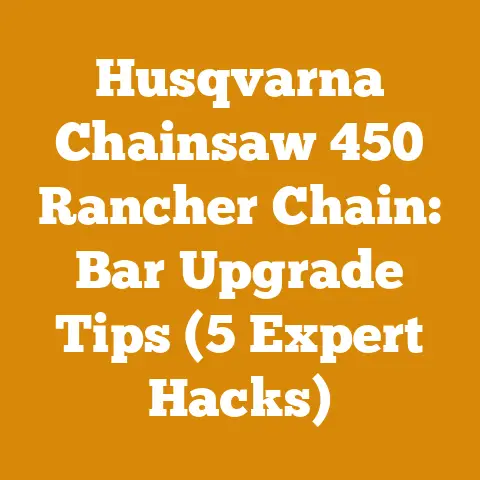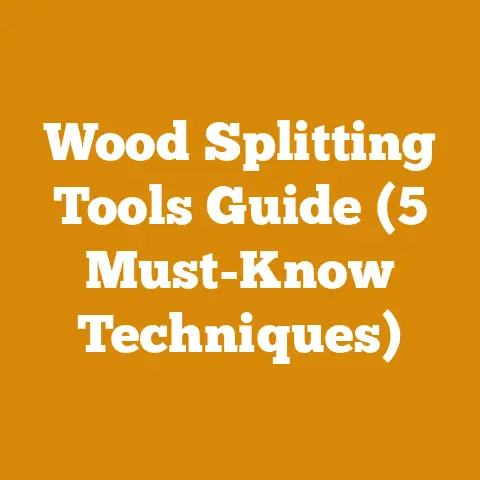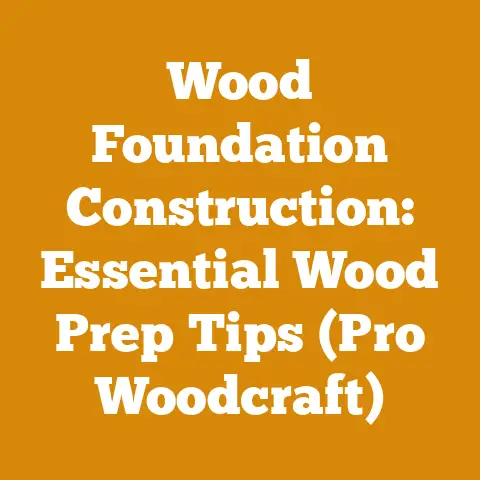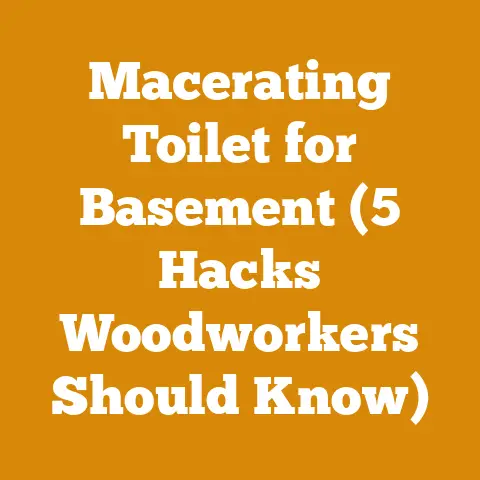Small Stump Grinding for Beginners (5 Rookie Pro Tips Inside)
Imagine your yard, finally free of that old, gnarled tree, but marred by the unsightly stump that remains.
It’s not just an eyesore; it’s a tripping hazard, a lawnmower obstacle, and a potential home for unwanted pests.
That’s where small stump grinding comes in.
I’ve spent countless hours wrestling with stubborn stumps, and I can tell you firsthand that while it might seem daunting, it’s a manageable task for the average homeowner with the right knowledge and a bit of elbow grease.
This guide is designed to equip you with the knowledge and techniques I’ve learned over the years to tackle small stump grinding projects safely and effectively.
Small Stump Grinding for Beginners (5 Rookie Pro Tips Inside)
Stump grinding is the process of using a specialized machine to chip away at a tree stump until it’s below ground level.
This allows you to reclaim the space for planting, landscaping, or simply enjoying a smoother, more appealing yard.
While professional stump grinding services exist, renting a small stump grinder and tackling the job yourself can save you money and give you a satisfying sense of accomplishment.
Let’s dive into the essential steps and insider tips to get you started.
Understanding the Basics of Stump Grinding
Before you even think about renting a stump grinder, it’s crucial to understand the fundamentals.
Not all stumps are created equal, and the type of wood, size of the stump, and surrounding environment will all influence your approach.
What is a Stump Grinder?
A stump grinder is a machine with a rotating cutting wheel equipped with hardened teeth.
This wheel spins at high speeds, grinding the wood into small chips.
Stump grinders come in various sizes, from small, portable models suitable for homeowners to large, powerful machines used by professionals.
I recommend starting with a smaller, walk-behind grinder for your first few projects.
Types of Stump Grinders for Small Jobs
For most homeowner projects, you’ll be looking at two main types of stump grinders:
- Walk-Behind Stump Grinders: These are the most common type for rental.
They are relatively easy to maneuver and can handle stumps up to a certain diameter (usually around 12-18 inches).
They are powered by gasoline engines, typically ranging from 13 to 25 horsepower. - Tow-Behind Stump Grinders: These are larger and more powerful, requiring a vehicle with a tow hitch.
They are suitable for larger stumps or multiple stumps but can be more challenging to maneuver in tight spaces.
Assessing the Stump and Surroundings
Before renting any equipment, I always take the time to thoroughly assess the stump and its surroundings.
This includes:
- Stump Diameter: Measure the diameter of the stump at its widest point.
This will help you determine the appropriate size of stump grinder to rent. - Root System: Examine the visible roots extending from the stump.
Larger roots may need to be cut with an axe or chainsaw before grinding. - Underground Utilities: This is the most important step.
Call your local utility companies (811 in the US) to mark any underground lines before you start digging or grinding.
Hitting a gas or electrical line can be extremely dangerous. - Obstacles: Identify any nearby obstacles, such as fences, buildings, or landscaping, that could be damaged by flying debris.
- Soil Type: The type of soil surrounding the stump can affect the grinding process.
Sandy soil is easier to grind than clay soil, which can clog the grinder.
Takeaway: Thoroughly assess the stump and surrounding area before renting any equipment. Safety first!
Preparing for the Grind: Safety First
Stump grinding is inherently dangerous.
The rotating cutting wheel can launch debris at high speeds, and the machine itself is heavy and powerful.
Therefore, safety is paramount.
I’ve seen firsthand the injuries that can occur when safety precautions are ignored.
Essential Safety Gear
- Safety Glasses or Goggles: Protect your eyes from flying wood chips and debris.
- Hearing Protection: Stump grinders are loud. Wear earplugs or earmuffs to prevent hearing damage.
- Gloves: Protect your hands from splinters and abrasions.
- Long Pants and Long-Sleeved Shirt: Provide additional protection from flying debris.
- Steel-Toed Boots: Protect your feet from injury.
- Dust Mask or Respirator: Protect your lungs from inhaling wood dust.
Creating a Safe Work Zone
- Clear the Area: Remove any loose objects, such as rocks, branches, or tools, from the work area.
- Establish a Safety Perimeter: Use caution tape or cones to create a perimeter around the stump to keep bystanders away.
A radius of at least 50 feet is recommended. - Inform Neighbors: Let your neighbors know you will be grinding a stump and that there may be some noise and flying debris.
- Never Operate Under the Influence: This should go without saying, but never operate a stump grinder if you are under the influence of alcohol or drugs.
Understanding the Stump Grinder’s Operation
- Read the Manual: Before operating the stump grinder, carefully read the owner’s manual.
Pay attention to the safety instructions and operating procedures. - Inspect the Machine: Before each use, inspect the stump grinder for any damage or wear.
Check the cutting teeth for sharpness and ensure that all guards are in place. - Practice in an Open Area: Before tackling the stump, practice operating the machine in an open area to get a feel for its controls and handling.
Takeaway: Safety is non-negotiable.
Wear the appropriate safety gear, create a safe work zone, and understand how to operate the stump grinder properly.
Step-by-Step Guide to Grinding a Small Stump
Now that you’ve assessed the stump, gathered your safety gear, and familiarized yourself with the stump grinder, it’s time to get to work.
Here’s a step-by-step guide based on my experience:
Step 1: Preparing the Stump
- Clear Debris: Remove any rocks, soil, or debris from around the base of the stump.
- Cut Protruding Roots: Use an axe or chainsaw to cut any large, protruding roots that could interfere with the grinding process.
I usually aim to cut them back to within a few inches of the stump. - Expose the Stump Base: Use a shovel to excavate the soil around the stump, exposing the base.
This will allow you to grind the stump below ground level.
I typically dig down about 4-6 inches.
Step 2: Positioning the Stump Grinder
- Position the Grinder: Position the stump grinder so that the cutting wheel is directly over the stump.
- Adjust the Height: Adjust the height of the cutting wheel so that it is slightly above the top of the stump.
- Engage the Brake: Engage the parking brake to prevent the grinder from moving during operation.
Step 3: Grinding the Stump
- Start the Engine: Start the engine according to the manufacturer’s instructions.
- Engage the Cutting Wheel: Slowly engage the cutting wheel.
- Sweep the Stump: Use a sweeping motion to move the cutting wheel across the stump.
Take small bites, moving the grinder back and forth.
Avoid forcing the wheel into the wood, as this can damage the machine. - Grind in Layers: Grind the stump down in layers, lowering the cutting wheel slightly with each pass.
- Grind Below Ground Level: Continue grinding until the stump is below ground level, typically 4-6 inches.
Step 4: Grinding the Roots
- Expose the Roots: As you grind the stump, you will encounter the roots.
Use a shovel to expose the roots and grind them down as well. - Follow the Roots: Follow the roots as far as you can, grinding them down below ground level.
Step 5: Filling the Hole
- Remove Debris: Remove any large chunks of wood or debris from the hole.
- Fill with Wood Chips: Fill the hole with the wood chips generated by the grinding process.
- Add Topsoil: Add a layer of topsoil over the wood chips.
- Compact the Soil: Compact the soil with a shovel or tamper.
- Seed or Sod: Seed or sod the area to restore the lawn.
Takeaway: Grind the stump in layers, using a sweeping motion.
Take your time and avoid forcing the cutting wheel into the wood.
5 Rookie Pro Tips for Stump Grinding
Over the years, I’ve learned a few tricks of the trade that can make stump grinding easier and more efficient.
Here are five rookie pro tips to help you get the job done right:
- Sharpen the Cutting Teeth: Dull cutting teeth will make the grinding process much slower and more difficult.
Before starting, check the sharpness of the teeth and sharpen them if necessary.
Many rental companies offer sharpening services.
A sharp tooth cuts efficiently. - Water the Stump: Watering the stump a day or two before grinding can soften the wood and make it easier to grind.
This is especially helpful for hardwoods like oak or maple.
Softer wood cuts faster. - Grind at an Angle: Instead of grinding straight down, try grinding at a slight angle.
This will help to prevent the cutting wheel from binding and will make the grinding process more efficient.
Angled cuts are easier. - Use a Tarp: Place a tarp around the stump to contain the flying wood chips.
This will make cleanup much easier and will prevent debris from damaging nearby landscaping.
A tarp saves time. - Take Breaks: Stump grinding can be physically demanding.
Take frequent breaks to avoid fatigue and prevent injuries.
Fatigue leads to mistakes.
Takeaway: Sharpen the teeth, water the stump, grind at an angle, use a tarp, and take breaks to make the grinding process easier and more efficient.
Choosing the Right Stump Grinder
Selecting the right stump grinder is crucial for a successful and efficient project.
The size and power of the grinder should be appropriate for the size and type of stump you’re tackling.
Rental companies typically offer a range of models, and their staff can provide guidance based on your specific needs.
Factors to Consider
- Stump Size: As mentioned earlier, the diameter of the stump is a primary factor.
Smaller, walk-behind grinders are suitable for stumps up to 12-18 inches in diameter.
Larger stumps may require a tow-behind model. - Wood Type: Hardwoods like oak, maple, and hickory are more difficult to grind than softwoods like pine or fir.
If you’re dealing with a hardwood stump, you may need a more powerful grinder. - Terrain: The terrain around the stump can also affect your choice.
If the ground is uneven or sloped, a smaller, more maneuverable grinder may be preferable. - Rental Cost: Stump grinder rental rates vary depending on the size and type of machine.
Be sure to compare prices from different rental companies. - Ease of Use: Consider your experience level when choosing a stump grinder.
If you’re a beginner, opt for a model that is relatively easy to operate.
Questions to Ask the Rental Company
- What is the maximum stump diameter this grinder can handle?
- How many horsepower does the engine have?
- What is the cutting wheel diameter?
- Are the cutting teeth sharp?
- Do you offer sharpening services?
- What safety features does the grinder have?
- Can you provide a demonstration of how to operate the grinder safely?
Takeaway: Choose a stump grinder that is appropriate for the size and type of stump you’re tackling.
Don’t hesitate to ask the rental company questions to ensure you’re selecting the right machine.
Dealing with Common Stump Grinding Challenges
Even with careful planning and execution, you may encounter some challenges during the stump grinding process.
Here are a few common problems and how to address them:
The Stump Grinder Won’t Start
- Check the Fuel: Make sure the fuel tank is full and that the fuel valve is open.
- Check the Spark Plug: Check the spark plug to make sure it is clean and properly connected.
- Check the Air Filter: A dirty air filter can prevent the engine from starting.
Clean or replace the air filter if necessary. - Check the Battery: If the stump grinder has an electric start, check the battery to make sure it is fully charged.
The Cutting Wheel is Binding
- Reduce the Feed Rate: If the cutting wheel is binding, reduce the feed rate (the speed at which you are moving the grinder across the stump).
- Grind at an Angle: As mentioned earlier, grinding at a slight angle can help to prevent the cutting wheel from binding.
- Sharpen the Cutting Teeth: Dull cutting teeth can cause the cutting wheel to bind.
- Check for Obstructions: Check for rocks, roots, or other obstructions that may be interfering with the cutting wheel.
The Stump Grinder is Overheating
- Check the Engine Oil: Make sure the engine oil is at the proper level.
- Clean the Cooling Fins: Clean the cooling fins on the engine to ensure proper airflow.
- Take Breaks: Allow the engine to cool down periodically by taking breaks.
- Check the Air Filter: A dirty air filter can cause the engine to overheat.
Flying Debris
- Use a Tarp: As mentioned earlier, using a tarp can help to contain the flying wood chips.
- Slow Down: Reducing the feed rate can also help to reduce the amount of flying debris.
- Wear Safety Glasses or Goggles: Always wear safety glasses or goggles to protect your eyes.
Takeaway: Be prepared to troubleshoot common problems.
Regular maintenance and careful operation can help to prevent these issues.
Alternative Stump Removal Methods
While stump grinding is often the most practical and efficient method for removing small stumps, it’s not the only option.
Here are a few alternative methods to consider, although I generally find them to be less effective or more labor-intensive for most situations:
Chemical Stump Removal
This method involves drilling holes in the stump and filling them with a chemical stump remover, typically potassium nitrate.
The chemical accelerates the decomposition of the wood, making it easier to break apart and remove.
- Pros: Relatively inexpensive, requires minimal physical effort.
- Cons: Can take several months to a year for the stump to fully decompose, may not be effective on all types of wood, can be harmful to the environment.
Manual Stump Removal
This method involves digging around the stump, cutting the roots, and pulling the stump out of the ground.
- Pros: No specialized equipment required.
- Cons: Extremely labor-intensive, especially for larger stumps, can be difficult to remove the entire root system.
Burning the Stump
This method involves building a fire on top of the stump and allowing it to burn down.
- Pros: Relatively inexpensive.
- Cons: Can be dangerous, requires a permit in some areas, can take several days for the stump to burn completely, can leave a large hole in the ground.
Natural Decomposition
This method involves simply waiting for the stump to decompose naturally.
- Pros: Requires no effort.
- Cons: Can take many years for the stump to fully decompose, the stump may attract pests and diseases.
Takeaway: Consider alternative stump removal methods, but be aware of their limitations and potential drawbacks.
For most homeowners, stump grinding is the most practical and efficient solution.
Post-Grinding Cleanup and Landscaping
Once you’ve successfully ground the stump, the final step is to clean up the area and prepare it for landscaping.
Removing Debris
- Rake the Area: Rake the area around the stump to remove any remaining wood chips and debris.
- Dispose of Debris: Dispose of the wood chips and debris properly.
You can use them as mulch in other areas of your yard, compost them, or dispose of them in your yard waste bin.
Filling the Hole
- Remove Large Chunks: Remove any large chunks of wood or debris from the hole.
- Fill with Wood Chips: Fill the hole with the wood chips generated by the grinding process.
This will help to prevent the soil from settling. - Add Topsoil: Add a layer of topsoil over the wood chips.
- Compact the Soil: Compact the soil with a shovel or tamper.
Landscaping
- Seed or Sod: Seed or sod the area to restore the lawn.
- Plant Flowers or Shrubs: Plant flowers or shrubs to add beauty and interest to the area.
- Install a Patio or Deck: Install a patio or deck to create an outdoor living space.
Takeaway: Clean up the area thoroughly, fill the hole properly, and landscape the area to restore your yard to its former glory.
Maintaining Your Lawn After Stump Grinding
After grinding the stump and filling the hole, it’s important to properly maintain the area to ensure healthy lawn growth.
Watering
- Water Regularly: Water the area regularly, especially during dry periods.
This will help the grass seed or sod to establish roots.
Fertilizing
- Fertilize the Area: Fertilize the area with a balanced fertilizer to provide the grass with the nutrients it needs to grow.
Weed Control
- Control Weeds: Control weeds by hand-pulling or using a selective herbicide.
Mowing
- Mow Regularly: Mow the area regularly to keep the grass at a healthy height.
Monitoring
- Monitor for Settling: Monitor the area for settling.
If the soil settles, add more topsoil and compact it.
Takeaway: Proper lawn maintenance is essential for a healthy and beautiful lawn after stump grinding.
Conclusion: Reclaim Your Yard with Confidence
Small stump grinding can seem like a daunting task, but with the right knowledge, tools, and safety precautions, it’s a project that most homeowners can successfully tackle.
By following the steps outlined in this guide and heeding my rookie pro tips, you can reclaim your yard from unsightly stumps and create a beautiful, functional outdoor space.
Remember to prioritize safety, choose the right equipment, and take your time.
The satisfaction of removing that stubborn stump and transforming your yard will be well worth the effort.
So, grab your safety gear, rent a stump grinder, and get ready to conquer those stumps!






